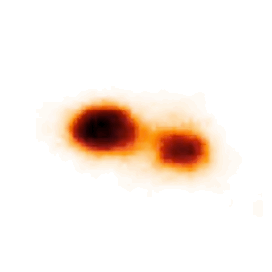Sheliak
|
Triple star β Lyrae / Sheliak |
||
|---|---|---|

|
||
| Image taken using the CHARA interferometer | ||
| } | ||
| Observation data epoch : J2000.0 |
||
| AladinLite | ||
| Constellation | lyre | |
|
Vis. Brightness (total) |
3.42 (3.30 to 4.35) mag | |
| Astrometry | ||
| parallax | (3.7 ± 0.5) mas | |
| distance | approx. 900 ly (approx. 300 pc ) |
|
| Individual data | ||
| Names | Aab, B, F | |
| Observation data: | ||
| Right ascension | Aab | 18 h 50 m 05 s |
| B. | 18 h 50 m 06.701 s | |
| F. | 18 h 50 m 06.952 s | |
| declination | Aab | + 33 ° 21 ′ 46 ″ |
| B. | + 33 ° 21 ′ 06.622 ″ | |
| F. | + 33 ° 21 ′ 07.266 ″ | |
|
Apparent brightness |
Aab | 3.4 to 4.6 m |
| B. | 7.13 m | |
| F. | 10.6 m | |
| Typing: | ||
| Spectral class | Aab | B7 Ve + A8 Vp |
| B. | B5 V | |
| F. | G5 | |
| Designations and catalog entries | ||
| Bayer-Bez. | β Lyrae | |
| Flamsteed-Bez. | 10 lyre | |
| Bright Star Cat. | HR 7106 | |
| Hipparcos catalog | HIP 92420 | |
| WDS catalog | WDS J18501 + 3322 | |
| ADS catalog | ADS 11745 | |
| Other names |
Sheliak, Struve 4039, FK5 705 | |
| Bonn diam. | Aab | BD + 33 ° 3223 |
| B. | BD + 33 ° 3224 | |
| F. | BD + 33 ° 3225 | |
| HD catalog | Aab | HD 174638 |
| B. | HD 174664 | |
| F. | HD | |
| SAO catalog | Aab | SAO 67451/67452 |
| B. | SAO 67453 | |
| F. | SAO | |
| Tycho catalog | Aab | TYC 2642-2929-1 |
| B. | TYC 2642-2930-1 | |
| F. | TYC 2642-1394-1 | |
Sheliak (from Arabic الشلياق, DMG aš-šiliyāq ), better known as β Lyrae (Beta Lyrae), is a star system in the constellation Lyra, about 900 light years away .
Sheliak is the namesake of the β-Lyrae stars , a class of eclipse variables whose components are so close together that they are elliptically deformed by their mutual gravity . Sheliak changes its apparent brightness with a period of 12.9075 days between +3.4 mag and +4.6 mag.
The main star is a spectroscopic binary star; its two components (Aa and Ab) are so close together that they cannot be resolved with ordinary optical telescopes . However, they can be detected spectroscopically : When the stars revolve around one another, a Doppler effect occurs, causing their spectral lines to shift periodically. In 2008, a spatially resolved image was taken using the CHARA interferometer .
The primary star is a B6-B8II giant with a mass of 8 solar masses, which loses mass to a B0.5V companion with a mass transfer rate of 10 −5 solar masses per year. The companion cannot be observed directly because it is covered by an accretion disk . Nevertheless, its mass could be estimated at 12.5 solar masses. In addition, a jet or bipolar discharge has been detected by inferometry as a result of accretion . Furthermore, due to the mass transfer, the period of the binary star system is shortened by 19 seconds per year.
The system includes the two additional visual components B and F. Component B is at a distance of 45.7 "at a position angle of 149 °; it is of the spectral type B5, has an apparent brightness of +7.1 mag and can already be seen in prism binoculars . The component F is at a position angle of 19 ° at an angular distance of 85.8 "and has an apparent brightness of 10.6 mag.
Three other potential components (C, D and E) do not appear to be physically part of the system.
Web links
Individual evidence
- ↑ bet Lyr. In: SIMBAD . Center de Données astronomiques de Strasbourg , accessed on November 2, 2018 .
- ↑ bet Lyr. In: VSX. AAVSO, accessed November 2, 2018 .
- ↑ Zhao, M .; Gies, D .; Monnier, JD; Thureau, N .; Pedretti, E .; Baron, F .; Merand, A .; ten Brummelaar, T .; McAlister, H .; Ridgway, ST; Turner, N .; Sturmann, J .; Sturmann, L .; Farrington, C .; Goldfinger, PJ: First Resolved Images of the Eclipsing and Interacting Binary β Lyrae . In: Astrophysical Journal Letters . tape 684 , no. 2 , 2008, p. L95 , bibcode : 2008ApJ ... 684L..95Z .
- ↑ Jamie R. Lomax, Jennifer L. Hoffman, Nicholas M. Elias II, Fabienne A. Bastien, Bruce D. Holenstein: Geometrical Constraints on the Hot Spot and Bipolar Outflows in Beta Lyrae . In: Astrophysics. Solar and Stellar Astrophysics . 2011, arxiv : 1108.3015v1 .
